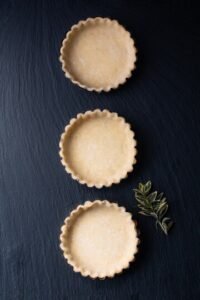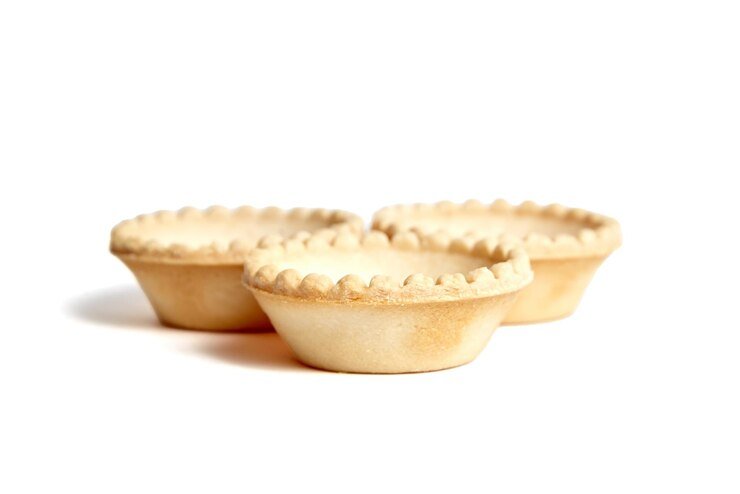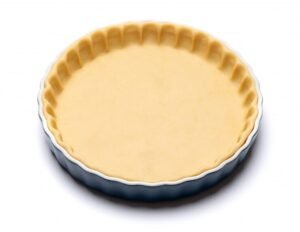Variations and Recipes
This section explores the creative aspects of making mini pie crusts, presenting various fat options that can alter the texture and flavor, as well as introducing diverse recipes that showcase the versatility of mini pie crusts.
Recipe Variations
The type of fat used in pie crusts can significantly affect their flavor and texture:
- Butter: Provides a rich flavor and tender crumb. It’s ideal for those who prefer a more flavorful crust.
- Shortening: Offers a flakier texture but with less taste. It’s great for achieving lofty layers.
- Combination of Both: Using a mix of butter and shortening can balance flavor and flakiness.
- Vodka: Adding a bit of vodka to the dough can make it more tender, as vodka evaporates quickly during baking, reducing gluten formation without adding moisture.
- Sour Cream: Incorporating sour cream helps the dough become more pliable and adds a slight tanginess, which can complement sweet or savory fillings.
Mini Pie Crust Recipes
Mini pie crusts can be filled with a plethora of ingredients to create delightful sweet or savory pies:
-
Fruit Pies:
- Apple Cinnamon Mini Pies: Fill with a mixture of diced apples, cinnamon, sugar, and a touch of nutmeg.
- Berry Mini Pies: Use a blend of blueberries, raspberries, and strawberries mixed with sugar and a bit of lemon zest.
-
Savory Tarts:
- Tomato and Basil Tarts: A filling of fresh tomatoes, basil, and mozzarella, seasoned with salt and pepper.
- Spinach and Feta Tarts: Combine spinach, feta, onions, and eggs for a rich savory tart.
-
Holiday-Themed Mini Pies:
- Pumpkin Mini Pies: Perfect for fall, these pies use a traditional pumpkin pie filling, enhanced with spices like cinnamon and cloves.
- Mini Mince Pies: A holiday classic, filled with mincemeat and topped with a dusting of powdered sugar.
Each recipe can be adapted to the mini format, providing the perfect bite-sized treat for any occasion, whether it’s a casual gathering, a formal dinner party, or a festive holiday event. By experimenting with these variations and recipes, you can cater to various tastes and dietary preferences, making your mini pies a customizable and much-loved choice.

FAQs
This section addresses frequently asked questions about mini pie crusts, providing valuable insights and solutions to common issues that bakers might encounter. These questions are derived from popular queries found in online search engines’ « people also ask » sections.
Frequently Asked Questions
- What is the best type of fat to use for flaky mini pie crusts?
- For the flakiest crusts, many bakers prefer a mixture of butter for flavor and shortening for texture. However, all-butter crusts are also very popular for their rich taste.
- Can I make mini pie crusts ahead of time and freeze them?
- Yes, mini pie crusts can be made in advance and frozen. Either freeze them raw in their tins and bake from frozen, adding a few extra minutes to the baking time, or pre-bake them and store in an airtight container.
- How do I prevent my mini pie crusts from shrinking during baking?
- Avoid overworking the dough, use cold ingredients, and let the shaped crusts chill in the refrigerator for at least 30 minutes before baking. Using pie weights during the first part of baking can also help maintain their shape.
- What are some creative fillings for mini pie crusts?
- Beyond traditional fruit fillings, consider savory options like cheese and vegetable tarts, or sweet variations like salted caramel and chocolate ganache.
- What are the best tools for making mini pie crusts?
- A mini rolling pin, precise dough cutters, and non-stick mini pie or muffin tins are essential. Pie weights and a pastry blender also make the process easier.
- How do I blind-bake a mini pie crust?
- To blind-bake, line the crust with parchment paper or foil, fill with pie weights or dried beans, and bake at a recommended temperature until the edges are golden. Then remove the weights and finish baking until the bottom is set.
Essential Resources for Mastering Mini Pie Crusts
Explore these curated resources to deepen your understanding and enhance your skills in crafting perfect mini pie crusts. Each link provides valuable insights and practical tips tailored to baking enthusiasts of all levels.


